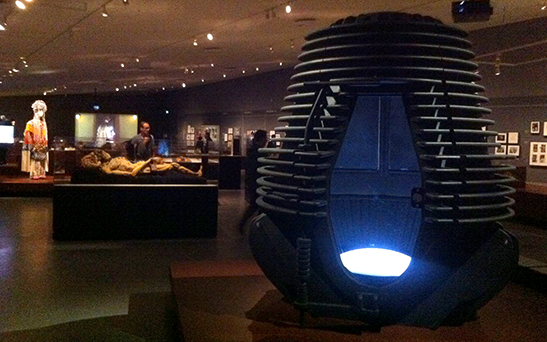
All of David Cronenberg has been playing at EYE as part of their third annual big director summer exhibit. Last year it was Fellini, two years ago Kubrick, and this year it’s all about Canadian body horror. The exhibit itself is pretty great, featuring an abundance of props from all of Cronenberg’s films alongside truly skin-curling film clips played in the dark. The whole thing definitely deserves to be rated R, so it is kind of inexplicable to us that someone would choose to bring their almost kindergarten age kid. But that’s exactly what happened, as one Dutch film aficionado introduced his kid to particularly gruesome clips of The Fly. Guess you can’t start that film school education too early!
The Cronenberg Exhibit goes through his oeuvre chronologically, which seemed to us a much more satisfying approach than the Fellini Exhibit last year which was organized according to the maestro’s “obsessions”. The Fellini Exhibit also lacked the props which made both the Kubrick and the Cronenberg so cool to see. On the whole, this exhibit does a much better job than last year’s of giving a thorough and entertaining intro to Cronenberg via clips, props and a reasonable number of explanatory texts.
Check out the exhibition pictures below before you read our eXistenZ review. Enjoy!





The last two pictures are, of course, from the eXistenZ section of the exhibit. This film was released in 1999, the year that also saw the release of The Wachowski Brothers’ The Matrix. This is striking coincidence, as eXistenZ can perhaps best be described as combination of The Matrix and Cronenberg’s own Videodrome from 1983, which was the last film before eXistenZ that Cronenberg both wrote and directed.
In the broadest sense eXistenZ is about how technology can have a physical and mental impact on humans. The film represents the continuation of a thought process Cronenberg first put to film in Videodrome. The same idea is central to both: that our interaction with technology has fundamentally altered what it means to be human. Both Videodrome and eXistenZ literalize this thought by showing technology that directly enters the body and finally leads to a blurring of the boundaries between the technological medium (video in Videodrome, game tech in eXistenZ) and the real world. Humans do not simply make use of technology, they incorporate it into themselves.
eXistenZ‘s serpentine plot starts out straightforwardly enough. The world’s top game designer Allegra Geller (Jennifer Jason Leigh) is conducting a test of her latest virtual reality game, called eXistenZ, which is powered by the bodies of its players and plugs into a hole shot into the bottom of their spinal cords. The test is interrupted when Geller is shot at and forced to flee with the gaming-phobic security guard/PR trainee Ted Pikul (Jude Law). Allegra eventually convinces Ted to play eXistenZ with her to check that the game still functions correctly and encounter a bizarre virtual world that mirrors the one they have left in strangely distorted ways. The boundaries between their real personalities and their game characters start to blur as they enter a game within a game by inserting a micro gamepod into the hole in their backs used to power the regular-sized gamepods Allegra invented.
If that sounds confusing, that’s only because to bewilder is clearly Cronenberg’s central goal. Much like The Matrix, eXistenZ is a virtual reality film that lives off a Baudrillardian confusion made literal on the screen: The created fictional world and material reality have become terrifyingly indistinguishable. Without giving too much away, we can say that at one point the question “Are we still in the game?” is asked, and the expressions on the faces of both the asker the asked — in addition to those on the faces of the audience — make it clear that no one can be sure.
Unlike The Matrix, however, the existential dilemma that faces the characters in eXistenZ is self-created. These humans are not oppressed, enslaved or deceived into living a false life, as is made abundantly clear from the beginning, when eager test players can’t wait to get to have eXistenZ plugged into their spinal holes. The threat facing human existence in Cronenberg’s world is the very human addiction to thrills and pleasures that are not available in everyday life. This is most strikingly exemplified by Willem Dafoe’s character, a gas-station operator known only as Gas, who proudly claims that thanks to Allegra’s game designs he now only operates a gas station “on the most pathetic level of reality”.
eXistenZ therefore conflates the roles of the perpetrator and the victim in one and the same character, meaning that our demise is self-imposed and we kind of like it. One might suppose that David Foster Wallace was a fan of Cronenberg, or if not, that he certainly should have been. The idea that humans are far more dangerous to themselves than to each other or than others are to them is not that also shines through in Cronenberg’s best known film, the body horror cult classic The Fly, and it certainly seems more interesting than the old good guys vs. bad guys routine.
3 out of 4 stars